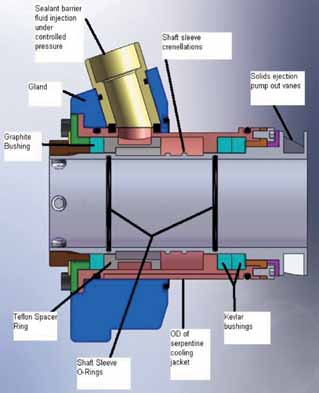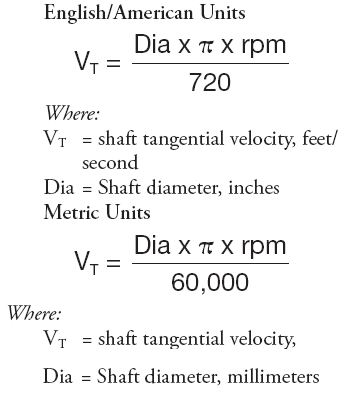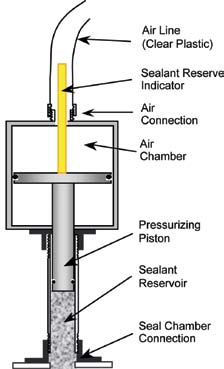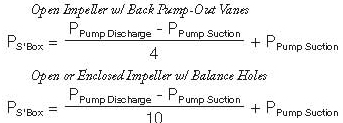Air-operated piston assembly, injectable and air flush enhance this sealing system's performance in harsh applications
A leak prevention system (LPS) is available that is effective in sealing pumpage with particulates and for clear liquids. It can be used with pumps, mixers, agitators, ribbon blenders, fans and sealing shafts for dry powder handling and includes fast and slow rotating equipment.
The Technology
The LPS is analogous to a double mechanical seal that uses a flexible sealant as a barrier fluid. This barrier fluid is maintained at a pressure slightly above stuffing box pressure by an air-operated piston. Close-fitting bushings at either end of the seal retain the flexible sealant. In essence, the LPS traps the sealant within the LPS assembly, and the pumpage has no chance to escape from the pump since it sees no leakage path.
The pressurizing sealant does not rotate with the shaft and, in remaining static, is actually a flexible stationary seat. The vertical edges of the machined crenellations (perpendicular to the shaft axis) act as rotating heads. In an LPS with two crenellations, four sealing surfaces are on the shaft sleeve.
Use with High and Low Shaft Speeds
The initial versions of the LPS were designed for low shaft speeds, with shaft peripheral velocity less than 0.5 meters/second (1.64 feet/second). These designs, typically used on blenders, mixers or progressing cavity pumps, require no cooling. Higher shaft peripheral speeds, such as those of most centrifugal pumps, require cooling of the LPS assembly. An illustration of the cooled LPS assembly as used in centrifugal pumps is shown in Figure 1.

Figure 1. Leak prevention system general arrangement
The cooling chamber is formed between the LPS housing and the bore of the existing pump stuffing box with an O-ring seal—the cooling medium does not contact the process liquid. Guide vanes in the cooling chamber distribute the flow from the in/out ports in a serpentine path.
The Kevlar bushings provide a tight clearance against the shaft sleeve, limiting any intrusion of the flexible sealant into the pump. Similarly, the graphite and Teflon bushing combination limit the flexible sealant from exiting the pump.
Crenellations on the shaft sleeve provide radial sealing surfaces to accommodate shaft movement due to deflection and/or vibration. For process pumps (e.g. ANSI or paper stock), a hook-type shaft sleeve is supplied to protect the pump shaft and to help position the impeller on the shaft as well as enabling axial travel for impeller clearance adjustment.
Since no process fluids migrate through the stuffing box, no solids will enter the seal assembly. Solids ejection vanes are furnished on the shaft sleeve to keep solids from settling on the bottom of the stuffing box.
Standard material of the seal assembly is 304SS and other materials can be furnished for compatibility with the pumped liquid.
Velocity Considerations
Shaft tangential or peripheral velocity is an important consideration when selecting the shaft seal type. Calculating this parameter can be accomplished with these equations:

Pressure Assembly
In the LPS, the pressure on the flexible sealant within the assembly is maintained at about 1 bar (approximately 15 psig) above stuffing box pressure. This is accomplished by an air-operated piston assembly. See Figure 2.

Figure 2. Sealant pressurizing assembly
The pressurizing piston provides a consistent and moderate pressure on the flexible sealant. This pressure is between four times and seven times the pressure in the air chamber, depending on the pump application and pressurizing device furnished. The required air pressure is calculated on a case-by-case basis.
Virtually no air consumption occurs for this device. If air pressure is lost, the seal will continue to operate for at least 45 minutes before leakage through the seal will occur. Once air pressure is restored, the seal will return to normal operation.
The sealant reservoir contains approximately 2 inches3 (33 centimeters3 or 60 grams) of sealant, which is sufficient for about 18 months of operation in most cases. If the reservoir needs to be replenished, this can be done while the pump is running and takes about three minutes.
The proximity rod can be fitted to engage a switch that activates a signal to an attendant when/if sealant has to be replaced in the reservoir. The signal can be a message to a cell phone, SCADA or other monitoring device. This allows a time period cushion of about three weeks in which the sealant reservoir can be replenished before the supply is exhausted.
Since the pressure on the flexible sealant must be maintained slightly above pump stuffing box pressure, calculating the stuffing box pressure, which is different for each pump type, is important. In many cases, the stuffing box pressure is the same as the pump suction or discharge. Some exceptions are:

When pump suction pressure is variable, use the higher value for suction pressure for the stuffing box pressure. If the pump is to be operated against a closed discharge valve at any time, use the pump discharge pressure at shut-off. If the pump is on a suction lift, the stuffing box may be at a pressure lower than atmospheric and air may be drawn through the shaft seal. This is no problem for the LPS since it can run dry indefinitely.
Flexible Sealant
The flexible sealant used in the LPS is also important. There are several types, but the most common is injectable packing. This has been available for decades for use in more traditional stuffing box arrangements in which the injectable packing is pumped into a stuffing box with a ring of packing at each end. In this mode, the injectable packing was intended to maintain a seal for the pumped liquid.
Over-pressurization during installation and the lack of packing pressure maintenance led to irregular and often unsatisfactory performance, such as leaky stuffing boxes. Conversely in the LPS, the injectable packing is held within the system assembly and forms a barrier through which the pumped liquid cannot pass. No over-pressurization occurs since the pressurizing piston assembly maintains a moderate and steady pressure.
The choice of a flexible sealant depends on the requirements of the application. Chemical compatibility, temperature, operating pressure, shaft tangential velocity and FDA certification for food-related products must be considered.
More than 400 variations of flexible sealant are available from injectable packing to high-viscosity greases. Higher stuffing box pressures may be accommodated by a Plan 13 seal piping arrangement.
Applications
Typical applications for the LPS include sealing a fluid where flushing the seal faces with water or another barrier fluid is undesirable, applications in which cavitation of the pump is a common occurrence and the cavitation destroys the seal faces in a short time or applications in which abrasives in the sealed fluid lead to premature seal face failure.
Pumping brine solution when dilution of the fluid with seal flush is not wanted can be particularly challenging for conventional mechanical seals. Salt particles in the brine are abrasive and wear traditional seal faces prematurely.
In pulp and paper, sealing black liquor can be problematic because of the need to flush the seal faces with water or another barrier fluid to prevent the liquor from solidifying on the seal faces and causing failure. Some black liquor processes purge the black liquor pumps with live steam while running to clean the system, causing severe pump cavitation. This procedure destroys seal faces in short order. The LPS is able to handle abrasive fluids easily and pump cavitation without failure.
New Developments
The latest development for the LPS is “air flush.” A small amount of compressed air, typically 0.17 SCFM at 8 psig, is fed to the back of the stuffing box via an internal port in the seal. This air forms a bubble between the back of the impeller and the back of the stuffing box. The bubble expands to create a torturous path even more difficult for the fluid pumped to penetrate than the pressurized sealant. The result is leak free
The LPS presents opportunities for handling tough-to-seal pump applications where traditional packing or mechanical seals cannot provide the performance required.
LPS Operating Parameters
LPS without cooling
Shaft tangential velocity: 0.5 meters/second (1.64 feet/second) maximum
Stuffing Box Pressure: 1.5 bar (22 PSIG) maximum
Temperature: 70 degrees C (158 degrees F) maximum
LPS with cooling
Shaft tangential velocity: 9.5 meters/second (31.6 feet/second) maximum
Stuffing Box Pressure: 3 bar (45 psig) maximum
Temperature: 315 degrees C (600 degrees F) maximum
LPS with air flush
Shaft tangential velocity: 9.5 meters/second (31.6 feet/second) maximum
Stuffing Box Pressure: 4 bar (60 psig) maximum
Temperature: 110 degrees C (230 degrees F) maximum
Pumps & Systems, November 2011

